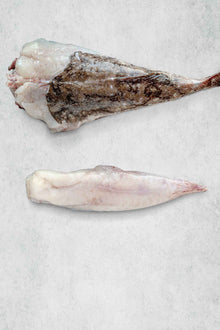Monkfish Fillet

Serves 1 - Min 150g
Filleted, Dark skin removed
£12.95
Monkfish has a luxurious lobster-like texture without the high price tag. Here’s why we think this delicious fish is a UK seafood must-try!
Come on. That’s not fair! Mackerel is an oily, flavourful athlete (snog), mussels are a sustainability superstar (marry), but monkfish…
They’re the ugliest fish in the sea! That whole joke about “why did the lobster blush? Because the sea-weed”—it’s not true! The lobster blushed because a monkfish swam past.
I couldn’t, I wouldn’t! They’re just too delicious. Plus, what a success story. There was a time when monkfish were considered a trash fish — fishermen wouldn’t even bother landing them because they couldn’t give them away. Cats would turn up their noses at the sight of a monkfish.
Food writers, meanwhile, fanned the flames. The legendary British food writer of the 1950s, Elizabeth David, called them “brutish” and “superbly equipped for the practice of gluttony.” While Alan Davidson, in his 1979 book North Atlantic Seafood, did them dirty by describing them as “miscellaneous” and “uncouth.”
But that’s all changed! Today, they’re fancy fish. Like James Bond in a tux driving an Aston fancy. Like served at the tables of all the top Mayfair restaurants fancy. Top of the Monopoly board fancy.
Well, sure. But that’s exactly why chefs today love them — and why we love them. They’re mind-bendingly delicious, yet still super affordable.
They’ve got this firm, meaty flesh with a distinctly lobster-like sweetness. It’s said that this is all down to their diet — monkfish have huge, powerful jaws that they use to crunch through literally thousands of kilos of shellfish. They are the epitome of “you are what you eat”.
Well, that’s just it. Their firm flesh makes them amazingly versatile and very difficult to cook badly.
They’re fantastic in something saucy, like a curry or a seafood risotto, while in France (where monkfish have always been loved), they call them lotte and traditionally pair them with a rich sauce américaine.
They’re fabulous in soups and chowders, and they’re even used as a langoustine alternative in scampi.
We love them best on a barbecue. Because the flesh doesn’t fall apart, you can really go bold with a bit of light charring on the grill. One of our favourite tricks? Making little kebab skewers out of rosemary sticks — the oils from the rosemary infuse into the fish, creating a real fireside showstopper.
That’s exactly why monkfish is starring in this summer’s barbecue box. When flame meets fish, you get monkfish magic — a barbecue upgrade like no other. Sorry, sausage, you’re off the menu.
It’s true. A whole monkfish would send any sensible fish buyer clutching for their phone to let Dr. Frankenstein know his monster’s escaped.
But that’s not the real reason. Well, at least not the only reason.
50% of a monkfish’s weight is in its head. They have big teeth, big jaws, and a mouth full of big fangs. Fishermen tend to cut the heads off before they even reach land — it’s just more practical.
Not at all! Monkfish heads make excellent crab pot bait — so at least the crabs get a little bit of recompense!
This means all of the fish gets used somewhere in the supply chain. Plus, monkfish stocks in the UK are exceptionally well managed, making them a great sustainable option.
In truth, we could eat more of the monkfish than we already do… Monkfish cheeks — while slowly rising in popularity among Britain’s more daring gastronomes — are rarely seen for sale, despite being totally delicious.
Meanwhile, the Japanese go crazy for monkfish liver. They call it ankimo, and it’s often described as “the foie gras of the sea”.
Good idea. If you’re cooking over a fire, we recommend monkfish tails. The cartilage in the tail acts as a natural structure, making it easy to handle over flames.
Meanwhile, fillets work best if you’re looking for a satisfying hunk of juicy meat — they’re fantastic roasted as a chop with garlic butter or fried and served in a zingy fish taco.
Absolutely not. At Rockfish, love is blind — and it’s very often followed by the word monkfish.